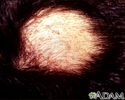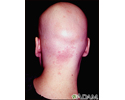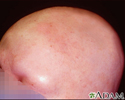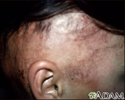Alopecia areata
Alopecia totalis; Alopecia universalis; Ophiasis; Hair loss - patchy
Alopecia areata is a condition that causes round patches of hair loss. It can lead to total hair loss.
Causes
Alopecia areata is thought to be an autoimmune condition. This occurs when the immune system mistakenly attacks and destroys healthy hair follicles.
Some people with this condition have a family history of alopecia. Alopecia areata is seen in men, women, and children. In a few people, hair loss may occur after a major life event such as an illness, pregnancy, or trauma.
Symptoms
Hair loss is usually the only symptom. A few people may also feel a burning sensation or itching.
Alopecia areata usually begins as one to several (1 cm to 4 cm) patches of hair loss. Hair loss is most often seen on the scalp. It may also occur in the beard, eyebrows, pubic hair, and arms or legs in some people. Nail pitting may also occur.
Patches where hair has fallen out are smooth and round in shape. They may be peach-colored. Hairs that look like exclamation points are sometimes seen at the edges of a bald patch with a magnifying tool.
If alopecia areata leads to total hair loss, it often occurs within 6 months after symptoms first start. This is called alopecia totalis when the entire scalp is involved, and alopecia universalis when the entire body is affected.
Exams and Tests
The health care provider will examine you and ask about your symptoms, focusing on areas where you have hair loss.
A scalp biopsy may be done. Blood tests may also be done to check for autoimmune conditions and thyroid problems.
Treatment
If hair loss is not widespread, the hair will often regrow in a few months without treatment.
For more severe hair loss, it is not clear how much treatment can help change the course of the condition.
Common treatments may include:
- Steroid injection under the skin surface
- Medicines applied to the skin
- Ultraviolet light therapy
A wig may be used to hide areas of hair loss.
Support Groups
More information and support for people with alopecia areata and their families can be found at:
- National Alopecia Areata Foundation -- www.naaf.org
Outlook (Prognosis)
Full recovery of hair is common.
However, some people may have a poorer outcome, including those with:
- Alopecia areata that starts at a young age
- Eczema
- Long-term alopecia
- Widespread or complete loss of scalp or body hair
When to Contact a Medical Professional
Contact your provider if you are concerned about hair loss.
References
Dinulos JGH. Hair diseases. In: Dinulos JGH, ed. Habif's Clinical Dermatology. 7th ed. Philadelphia, PA: Elsevier; 2021:chap 24.
Gawkrodger DJ, Ardern-Jones MR. Disorders of hair. In: Gawkrodger DJ, Ardern-Jones MR, eds. Dermatology: An Illustrated Colour Text. 7th ed. Philadelphia, PA: Elsevier; 2021:chap 38.
Alopecia areata with pustules - illustration
Alopecia areata with pustules
illustration
Alopecia totalis - back view of the head - illustration
Alopecia totalis - back view of the head
illustration
Alopecia totalis - front view of the head - illustration
Alopecia totalis - front view of the head
illustration
Alopecia, under treatment - illustration
Alopecia, under treatment
illustration
Alopecia areata with pustules - illustration
Alopecia areata with pustules
illustration
Alopecia totalis - back view of the head - illustration
Alopecia totalis - back view of the head
illustration
Alopecia totalis - front view of the head - illustration
Alopecia totalis - front view of the head
illustration
Alopecia, under treatment - illustration
Alopecia, under treatment
illustration
Review Date: 11/30/2022
Reviewed By: Elika Hoss, MD, Senior Associate Consultant, Mayo Clinic, Scottsdale, AZ. Also reviewed by David Zieve, MD, MHA, Medical Director, Brenda Conaway, Editorial Director, and the A.D.A.M. Editorial team.








